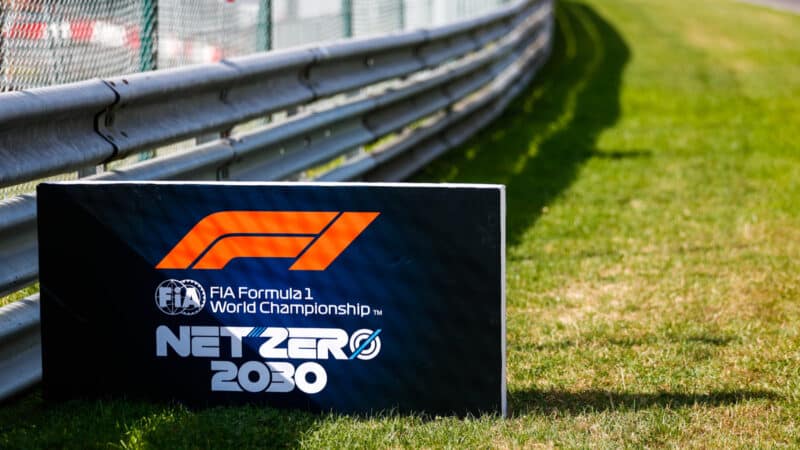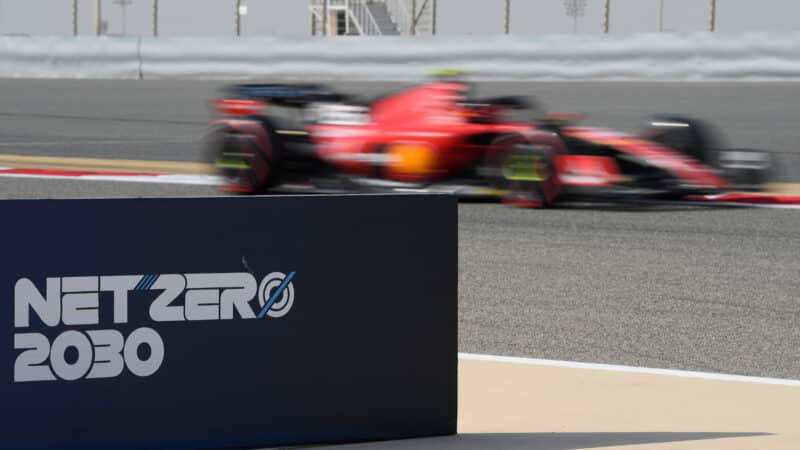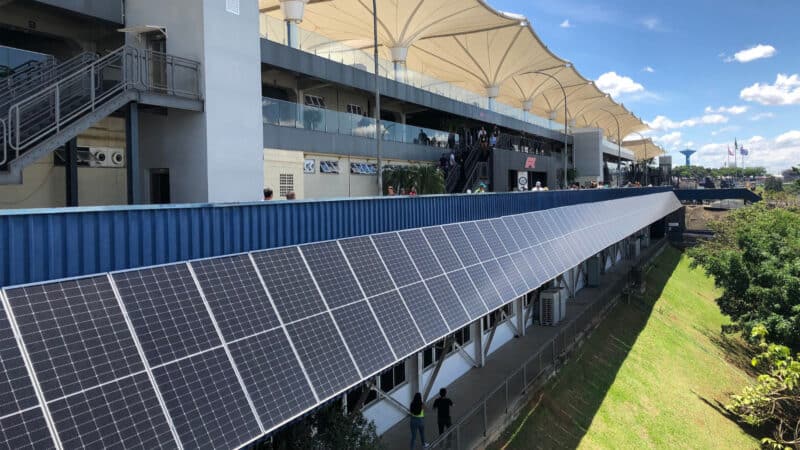The questions behind F1’s Net Zero claims
Formula 1 has made real progress in cutting its carbon footprint - but staying on track to Net Zero by 2030 might demand tougher decisions

Getty Images
The latest in a series of press releases announcing the progress towards achieving its Net Zero goal showcases how much Formula 1 has moved forward on the road to becoming a more sustainable sport.
The new figures suggest progress: a 26% reduction in carbon emissions between 2018 and 2024, with drops across team factories, freight, and events.
“Today’s results are the product of years of hard work across the sport,” Ellen Jones, the head of ESG (Environmental, Social, & Governance) at Formula 1, said in the statement released by the championship on Wednesday.
“All areas have been tasked with operating more sustainably, and it is through this sport-wide engagement and delivery that we are able to achieve such significant emissions reductions.
“Looking ahead, we have a clear plan to meet our commitments and to further demonstrate how growth can be positive for both sustainability and sporting outcomes.
“Formula 1 is uniquely placed to show that performance and sustainability can support one another, and I look forward to seeing the impact of initiatives already announced – such as changes to our race calendar from 2026 – as well as those yet to come, to help us deliver on our goals and beyond,” she added.
Much to F1’s credit, meaningful strides in cutting its carbon footprint have been made over the past years, even as the championship has grown in popularity and to a record 24-race calendar.
According to F1’s own data, the overall carbon footprint in 2024 was 168,720 tonnes of carbon dioxide equivalent (tCO₂e — a measure of several greenhouse gases, based the amount of CO2 that would have the same global warming effect). That’s a reduction from 228,793 tCO₂e in 2018, despite significantly more fans, travel, and global infrastructure.
Among the most notable achievements is a 59% reduction in emissions from F1 facilities, driven by a switch to renewable energy sources across team factories and F1-owned buildings; a 25% cut in travel-related emissions, with increased use of remote working and better flight logistics; a 9% reduction in logistics emissions, thanks to more efficient Boeing 777F freighters and the expanded use of biofuel-powered trucks for European freight; and a 12% reduction in event emissions, due to smarter venue operations and renewable energy at races.

F1 has promoted its Net Zero plan intensively
Grand Prix Photo
Perhaps most impressively, they came during a period in which race attendance increased by 2.5 million and F1’s commercial reach continued to expand.
However, behind the positive headlines lie important questions about methodology, transparency, and whether the most difficult part of F1’s climate journey has even started.
Moving the goalposts?
Formula 1’s plan to become a Net Zero operation involves cutting its emissions by 50%, with the remaining half to be offset through verified carbon projects.
In its latest statement, F1’s claim of a 26% reduction is based on a revised 2018 carbon baseline of 228,793 tCO₂e.
But back in 2019, when the Net Zero pledge was first announced, the championship had published a higher figure: 256,551 tCO₂e.
The shift in baseline, now attributed to “improved data and methodology”, changes how F1’s progress is measured.
For example, had the original number been used, the same 2024 emissions figure would represent a 34% drop – not 26% – making the current progress look more impressive.
However, sticking to the original, higher baseline would also have meant a higher 2030 emissions cap – 128,275 tCO₂e, compared to 114,396 tCO₂e under the revised one.
In other words, although the percentage progress would seem greater, the remaining reductions required to hit the Net Zero goal are now steeper.
So while revising the baseline may reflect better data, it also complicates transparency.
F1 has, in effect, moved the start line closer to the finish, which makes the race to Net Zero look a bit shorter in hindsight, but harder to win from here.
The travel question
Formula 1’s biggest climate challenge is essentially baked into its DNA: it’s a global championship that flies 10 teams (11 next year), thousands of personnel, and tonnes of equipment to 24 locations across the world.

The paddock is still an big energy-consuming place
Grand Prix Photo
Despite improvements like more efficient cargo planes, expanded use of biofuel trucks in Europe, and more remote work, travel and logistics still account for the largest portion of F1’s emissions.
Cutting this further may demand structural changes that the championship has so far avoided.
While the 2026 calendar goes some way towards regionalising the schedule for more efficient logistics and therefore lower emissions, the commercial aspect is still a factor that often wins over environmental logic.
For example, from the perspective of personnel logistics, scheduling the Miami and Canadian Grands Prix back-to-back would have been more practical, since most F1 and team staff would otherwise return to Europe during the three-week break between these events.
This arrangement would minimise travel disruptions and improve operational efficiency for the teams, but financial considerations had preference over environmental concerns.
F1 is also looking to Sustainable Aviation Fuels (SAFs) as a major solution. However, SAFs remain costly, limited in supply, and come with their own trade-offs – including land use, scalability, and residual emissions.
SAFs can reduce emissions by up to 80%, but they are not carbon-neutral, and widespread SAF adoption is years away, and even then, it’s unlikely to eliminate aviation’s climate impact entirely.
So while SAFs reduce aviation’s environmental impact, they do not eliminate it completely, which is one of the reasons F1 may yet face the toughest part in its Net Zero plan.
The offset trap
As pointed above, F1 is targeting a minimum 50% emissions reduction by 2030, with the remaining part being offset “using credible programmes in line with latest best practice guidance”, according to the statement.
For pretty much every big company aiming to become Net Zero, offsetting its emissions by 2030 is often the most controversial part of their plan.

Several circuits have adopted new sustainable solutions
On paper, offsetting the remaining part of your emissions is a good plan. However, in practice, offsetting at scale is fraught with problems.
Many airlines rely heavily on cheap, low-quality offsets with uncertain long-term benefits and often make misleading claims about carbon neutrality to make passengers feel better about flying, and that’s a trap big companies must avoid if they want their Net Zero plans to have credibility.
Many carbon credit schemes have been exposed as overinflated or meaningless.
For example, a 2023 investigation by The Guardian, Die Zeit, and SourceMaterial revealed that over 90% of rainforest-based carbon credits certified by Verra — the world’s largest carbon offset certifier — were essentially worthless.
These credits were issued for projects that claimed to protect forests under threat, but the threats were often exaggerated or non-existent. Yet companies like Shell and Disney used them to claim climate progress.
Even when well-intentioned, offsets are often unverifiable, temporary (trees can burn or be cut down), or double-counted by other entities.
Scaling up to cover tens of thousands of tonnes annually, as F1 will need to do, pushes into deeply uncertain territory.
If F1 is serious about using credible offsets, it will need to be transparent about which ones it is investing in, how many tonnes they cover, and whether those schemes hold up to independent scrutiny.
Without clear disclosure of what gets counted and how, offsetting is just a slogan, not a standard.
Where things get difficult
As noted above, Formula 1 has done an incredible job in making progress towards its Net Zero goal since announcing its plan at the end of 2019.

F1’s growing popularity doesn’t help with reaching sustainability goals
The behind-the-scenes effort has been considerable and deserves credit.
However, as F1 continues to attract more fans and broaden its global reach, maintaining momentum on decarbonisation will require even more innovation and discipline across travel, logistics, and event management.
Making the calendar, the grid, or the audience grow only makes the challenge even bigger, demanding not only technological solutions but also collective effort from teams, promoters, and partners to offset the growing environmental impact.
The feel-good headlines about F1’s sustainability story will keep on coming over the following years, but transparency will be essential to make sure that the plan is seen as a lot more than just a PR exercise.
